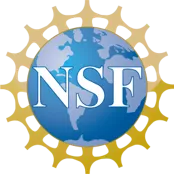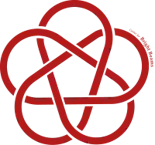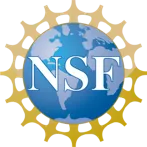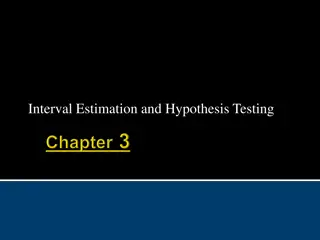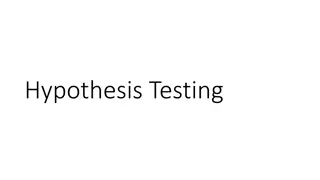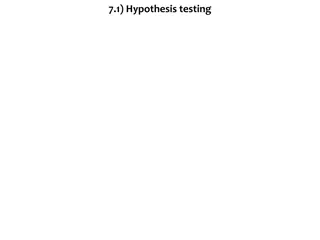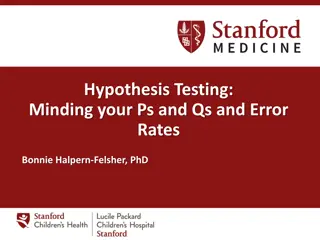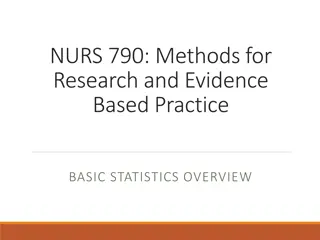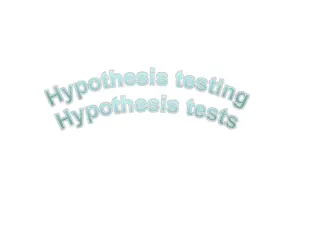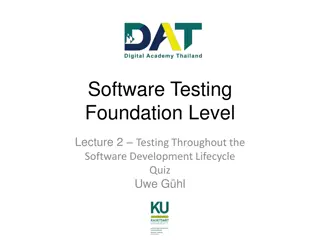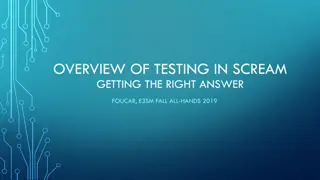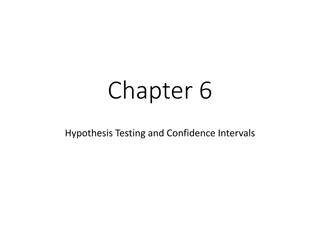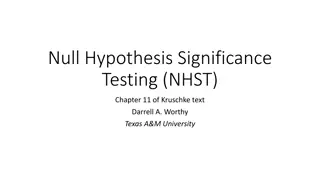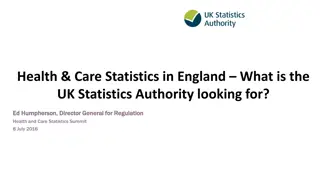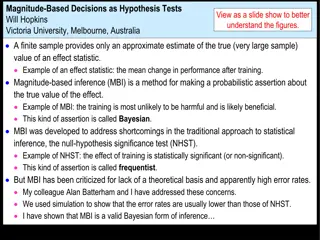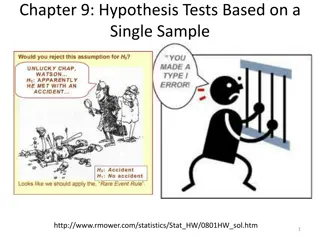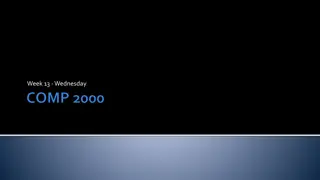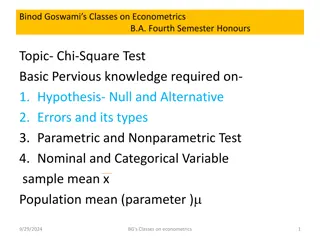Hypothesis Testing in Statistics
Hypothesis testing is a fundamental statistical method used to investigate and make decisions based on experimental data. It involves formulating null and alternative hypotheses, selecting a level of significance, identifying test statistics, and applying decision rules. By following a five-step procedure, researchers can determine whether to reject the null hypothesis in favor of the alternative hypothesis. Understanding the concepts of null and alternative hypotheses is crucial in interpreting sample data and drawing meaningful conclusions in statistical analysis.
Download Presentation

Please find below an Image/Link to download the presentation.
The content on the website is provided AS IS for your information and personal use only. It may not be sold, licensed, or shared on other websites without obtaining consent from the author.If you encounter any issues during the download, it is possible that the publisher has removed the file from their server.
You are allowed to download the files provided on this website for personal or commercial use, subject to the condition that they are used lawfully. All files are the property of their respective owners.
The content on the website is provided AS IS for your information and personal use only. It may not be sold, licensed, or shared on other websites without obtaining consent from the author.
E N D
Presentation Transcript
Near-Threshold Nonlinear Photoemission from Cu(100) Christopher Knill Arizona State University Coauthors: Siddharth Karkare (ASU), Howard Padmore (LBNL) P3 This work was supported by the U.S. National Science Foundation under Award No. PHY-1549132, the Center for Bright Beams and by the Department of Energy under Grant No.DE-SC0021092.
Introduction Photocathodes that have a low mean transverse energy (MTE) are crucial to the development of compact X-ray Free Electron Lasers and ultrafast electron diffraction experiments MTE is dependent upon excess energy [1] and nonlinear photoemission effects [2,3] Here we present measurements of nonlinear photoemission near threshold on Cu(100) We extrapolate our data to gain insight into the affects of nonlinear photoemission on the MTE at a wavelength and fluences typically used in photoinjectors. [1] [2] [3] P. Musumeci et al, Nucl. Instrum. Meth. A. 907, 209 (2018). J.K. Bae et al, J. Appl. Phy. 124, 244903 (2018). J Maxson et al, Nuc. Instrum. and Meth. in Phys. Res. A 865, 99-104 (2017). cknill2@asu.edu 2
Results 110 10 7 mJ/cm2 100 260 nm 290 nm Measured work function of 4.56 eV Approximately coincides with minimum MTE at low fluence MTE increases due to Above threshold: excess energy Below threshold: nonlinear photoemission MTE (meV) 90 80 70 60 4.4 4.5 Photon Energy (eV) 4.6 4.7 4.8 J.K. Bae et al, J. Appl. Phy. 124, 244903 (2018). cknill2@asu.edu 3
280 nm 400 - 0.13 eV excess energy Nonlinear effects have: Enormous impact on MTE Small impact on QE 300 MTE (meV) 200 100 0 10-6 10-5 Fluence (mJ/cm2) 10-4 10-3 105 100 5 pJ 1.06 pJ .274 pJ .088 pJ .028 pJ Electron Counts Counts per second 104 10-2 10-4 103 10-6 102 10-6 10-5 Fluence (mJ/cm2) 10-4 10-3 0 2000 4000 6000 8000 10000 Longitudinal Energy (meV) cknill2@asu.edu 4
Extrapolation to 265 nm ?(nm) Count/sec MTE (mev) Fluence (mJ/c??) Not possible to measure 265 nm at high fluence with Energy Analyzer [4] 265 46500 (??) 200 (??) 52300 (???) 74 (????) 72.52 (????) 533 (?????) 3.82 x 10 7 (??) 2.28 x 10 6 (??) 5.63 x 10 4 (???) 280 290 1 ? ?? ???? ?? ? +??? ????? ??? ??? = 2 265 nm Accuracy check at 280 nm ? 600 Where: 400 Calculated Measured 500 ?? ?? ? ??? ??? ? ? = + 300 MTE (meV) 2 400 MTE (meV) ??: Electron counts per second ??: Fluence (mJ/c?2) ????: MTE (meV) Subscripts ?:Linear component ??: Nonlinear component Provides lower limit on MTE [4] S. Karkare et al, Rev. Sci. Instrum. 90, 053902 (2019). 300 200 200 100 100 0 0 10-2 10-1 Fluence (mJ/cm2) 100 101 102 10-6 10-5 Fluence (mJ/cm2) 10-4 10-3 cknill2@asu.edu 5
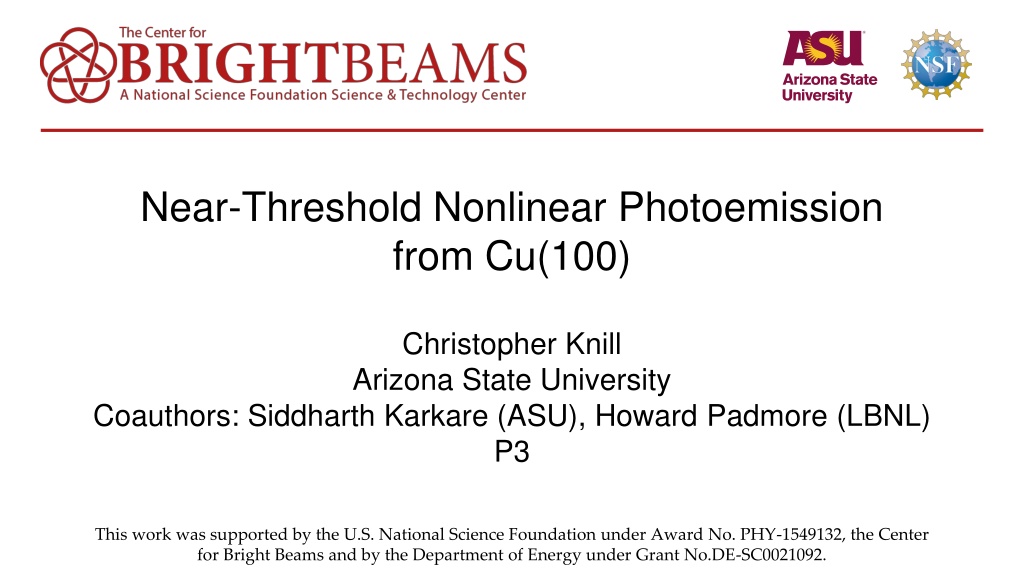
 undefined
undefined
